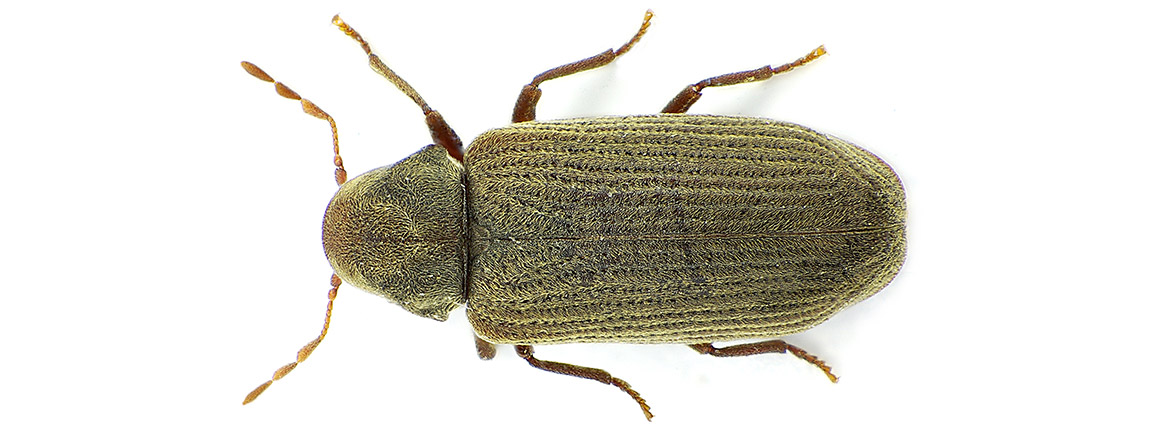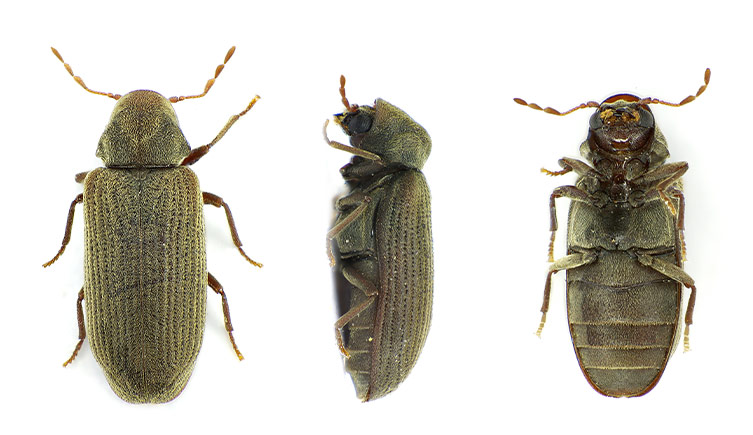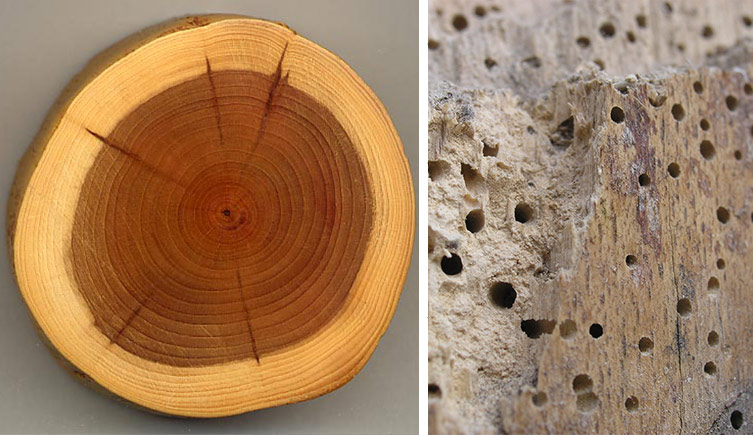The furniture beetle (Anobium punctatum), or woodworm, often causes damage to structural timber such as wood framed roofs, floor boards and joists.

An adult furniture beetle © Siga (CC BY-SA 3.0) via Wikimedia Commons.
Identification
Adult beetles are 2.5-5 mm in length and dull reddish to dark brown. They have fine grooves running lengthways along the wing-cases and antennae shorter than legs, with three flattened segments at the tip of the antennae. The beetles head is hidden by the upper part of the beetle's thorax (its mid-section), which is very strongly humped, like a monk’s cowl.
There is possible confusion with the biscuit beetle (Stegobium paniceum) which eats stored food. Biscuit beetles are lighter brown, have antennae the same length or longer than their legs, and do not have a humped thorax.

The adult furniture beetle. The beetle's head is mostly hidden under the humped top of its thorax (the middle body section), giving it a 'monk's cowl'. The adult beetle has a body length of 2.5-5 mm. © Siga (CC BY-SA 3.0) via Wikimedia Commons. Composite of three images.
Distribution and habitat
On dry wood of deciduous and coniferous trees; it likes ivy. Woodwork and furniture in houses, stores, warehouses in Europe; widespread in Britain. Causes more damage in structural timber and joinery, for example in the attic, rather than in furniture.
Life cycle
Four life-stages: egg, larva, pupa and adult. Speed of development depends on type of wood, temperature, and humidity. Larval development takes 3-5 years. The adults don’t feed. They emerge from the wood in early summer and live for 2-4 weeks during which the female lays 20-100 eggs that hatch in 3-5 weeks.
The larvae bore straight into the wood making a hole indiscernible to the naked eye. They are cream-coloured and C-shaped. They feed and grow within the wood producing a network of tunnels packed with bore dust. Full-grown larvae change into pupae and, after 6-8 weeks, into adult beetles.
As the adults exit the larval tunnels, they leave behind round exit holes 1.5-2 mm wide, and small piles of wood dust (frass) characteristic of woodworm damage.
Damage and control
Prevention is the key. The beetles attack the seasoned sapwood, not live or fresh wood. Wood must be treated before use. They usually avoid heartwood. Furniture beetles can cause serious damage to structural timbers if left unchecked.
Infestations can be controlled by application of a residual insecticide (such as permethrin), professional fumigation and/or replacing affected wood.

The left image shows the difference between the outter sapwood and inner heartwood of a yew tree (there is no beetle damage in this wood). the right image shows woodworm damage in beech wood. Left image © MPF (CC BY-SA 3.0) via Wikimedia Commons. Right image © KaiMartin (CC BY-SA 3.0) via Wikimedia Commons.
More information
Download this information sheet on the furniture beetle as a PDF (295KB)
Elsewhere on the internet:
Common insect pest species in homes
Back to the Common Insect Pest Species in Homes guide

Identify your finds 🔍
Need help in indentifying what you've seen?
Our ID guides and expert team are here to assist you.
Don't miss a thing
Receive email updates about our news, science, exhibitions, events, products, services and fundraising activities. We may occasionally include third-party content from our corporate partners and other museums. We will not share your personal details with these third parties. You must be over the age of 13. Privacy notice.
Follow us on social media